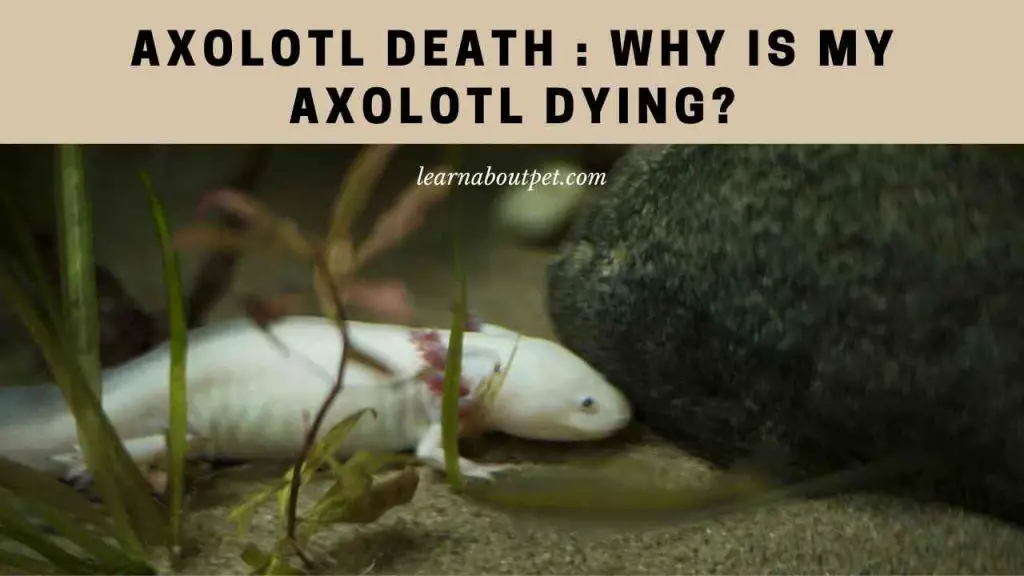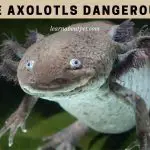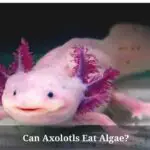Some of the most frequently asked questions about axolotls are on how they look when they die and what causes their deaths. In this article, we explore these issues comprehensively.
Axolotl death happens due to disease, parasites, impaction, improper feeding, poor water conditions and old age. A dead axolotl will normally be very stiff, completely unresponsive to touch and rather pale in color. Its gills will normally curve, and its mouth will be wide open. In water, it may tend to float.

What Does A Dead Axolotl Look Like?
Firstly, a dead axolotl will tend to be very pale in color. Of course, an axolotl can also become very pale in color even while alive. Therefore paleness alone is not enough to declare an axolotl dead. But if it is accompanied by other signs of a dead axolotl, then it is significant.
Secondly, a dead axolotl will normally be very stiff. It will be stiff in a lifeless manner, like an innominate object.
Thirdly, a dead axolotl will normally have its mouth wide open. This scenario, where you have an axolotl dead mouth open, is typically due to stiffening of muscles: which then causes the mouth to be wide open.
Fourthly, a dead axolotl’s gills will tend to have some curvature.
One may ask, at this point, do dead axolotls float? Is floating a sign of death in axolotls? This is because there seems to be some controversy on this aspect.
So, indeed, do axolotls float when they die? The answer is ‘yes’. Dead axolotls will normally float. Of course, even axolotls that are alive can float. But dead axolotls float in a lifeless manner, like tubes.
Further, an axolotl that is dead will normally be completely unresponsive to touch. Even when you poke it, it won’t respond at all. Therefore an axolotl unresponsive even to the strongest of stimuli may indeed be dead.
Now it is important to note that these are signs of death in real life axolotls. The dead axolotl minecraft game enthusiasts may encounter may have other signs of death.
While at it, what do dead axolotl eggs look like? How to tell if axolotl eggs are dead is by looking at their color and shape. Dead ones will normally have a cloudy/milky appearance, normally with some swelling.
What Can Kill An Axolotl?
There are many things that can kill an axolotl.
Firstly, there are several diseases that can kill an axolotl. If an axolotl becomes ill, and doesn’t get treatment (or heal naturally), then it may end up dying.
Secondly, poor water conditions may kill an axolotl.
If, for instance, the water has too many toxins like ammonia, it can cause deadly axolotl complications. If you don’t change the water regularly, or if you use chlorinated water or if you don’t filter the water, it may kill the axie.
Thirdly, overfeeding or underfeeding the axolotl can end up killing it.
Fourthly, impaction (say, from ingesting gravel in the tank) can end up killing an axolotl.
Fifthly, parasites can kill an axolotl. These may be parasites that get into the axolotl through various types of live food.
Sixthly, an axolotl may just die naturally, out of old age.
So those are some of the things that can kill an axolotl.
Do Axolotls Play Dead?
One question that commonly comes up, in discussions revolving around axolotl deaths, is on whether axolotls can play dead.
So, indeed, do axolotls play dead? The answer is ‘yes’. And this is why, even if you strongly suspect that your axolotl is dead, you still need to confirm.
As many axolotl owners will tell you, the phenomenon of an axolotl playing dead is a relatively common one.
So common is it that even minecraft game creators have incorporated it. And the axolotl playing dead minecraft enthusiasts encounter behaves more or less like its real life counterpart.
Sometimes, while interacting with your axolotl, it may suddenly become completely unresponsive and exhibit several other signs of death.
That can get you worried and exclaiming, I killed my axolotl! Then the thing springs back to life, much to your great relief.
Therefore playing dead is something axolotls do. And you need to be sure that an axolotl is genuinely dead, before declaring it so.

Can An Axolotl Come Back To Life?
If what you have is a genuinely dead axolotl, then it obviously can’t come back to life. That is because real death is irreversible.
But if what you have is an axolotl that was playing dead, then it may be possible for it to spring back to life.
How Long Do Axolotls Live?
Normally, axolotls live for between 10 and 15 years.
But it is also possible for one to end up with a dead baby axolotl. In other words, whereas axolotls live for between 10 and 15 years, some do die well before that age. Some actually die while still babies.
In fact, others die before they hatch. So you end up with dead axolotl eggs. And each dead axolotl egg could potentially have hatched into a beautiful axie.
This is why any game of deadpool axolotl owners create would be a high risk one. Deadpool is a game where people try to predict the date of death, sometimes with money bets.
But because an axolotl is a relatively delicate pet, it is easy to get one or another aspect of its care wrong, leading to death. So whereas axolotls normally live for 10 to 15 years, it can hard to predict how long exactly yours will live.
All in all though, if you have an axolotl that dies at the age of, say, 15 years then it may be on account of old age.
What Can Kill An Axolotl Prematurely?
If, for instance, you observe that your axolotls are dying young, you may start wondering, why are axolotls dying prematurely?
Now one common cause of premature death in axolotls is improper water conditions.
If, for instance, you go without changing the water that axolotls live in for too long, leading to accumulation of ammonia, you can end up with premature death.
If you put axolotls in chlorinated water or unfiltered water, there may be a trend of premature axolotl deaths.
Another common cause of premature death in axolotls is parasite infestation. If you get your axolotl live food from dubious sources, it may come with nasty parasites that eventually kill the axies.
Yet another common cause of premature death in axolotls is improper feeding. If you overfeed or severely underfeed your axolotl, it may end up dying prematurely.
If you introduce gravel pieces that are small enough for axolotls to eat, they may keep eating them, leading to impaction and premature death.
Various diseases can also cause axolotls to die prematurely.
What Do You Do With A Dead Axolotl?
This is what to do with a dead axolotl.
Firstly, it is essential for you to really investigate, to know what killed the axolotl. This way, you can take measures to prevent axolotl death in the future for other pets.
Secondly, you need to figure out how you will dispose of the axolotl’s body. But first, it may be a good idea to freeze the axolotl’s body, in order to kill any pathogens in it, before proceeding any further.
The actual disposal of the body may be by way of burial in your backyard or burial in a pet cemetery (where those are available). The option of cremating the axie and keeping the ashes in its memory may also be there.
Final Verdict – Axolotl Death
A dead axolotl will normally be completely unresponsive to touch. It will also tend to be very stiff, and pale in color with curved gills. In water, it will tend to float. And it normally has its mouth wide open.
Common causes of death in axolotls include disease, improper feeding, impaction (for instance, from eating gravel), parasites and old age.
Axolotls are also known to play dead. Therefore it is important to be sure that an axolotl is actually dead, before declaring it so.

Axolotl death is tough to handle. If an axolotl is indeed dead, it is a good idea to freeze it for some time, before disposing of its body. This is in order to kill any pathogens that may be still in its body.
You can dispose of the body of a dead axolotl by way of burial or cremation (where pet cremation services are available).
As a pet lover, make sure to learn about pet more and give your pet axolotl a good and comfortable life!

Welcome to Learn About Pet. My name is Rajkumar Ravichandran and I love all pets, travel, and amazing food. I write about my passion and personal experience caring for multiple pets in this blog! ❤️
Post Disclaimer
DISCLAIMER: THIS BLOG OR WEBSITE, "Learn About Pet", DOES NOT PROVIDE YOU WITH MEDICAL ADVICE AND IS NOT A SUBSTITUTE FOR MEDICAL ADVICE. ALWAYS GET IN TOUCH WITH YOUR PERSONAL VETERINARIAN AND USE INFORMATION HERE AS GENERAL ADVICE.
The information, including but not limited to, text, graphics, images and other material contained on this website are for informational purposes only. No material on this site is intended to be a substitute for professional veterinary advice, food recommendation, diagnosis, or treatment. Always seek the advice of your veterinarian or other qualified health care provider with any questions you may have regarding a medical condition or for pet food related questions.







